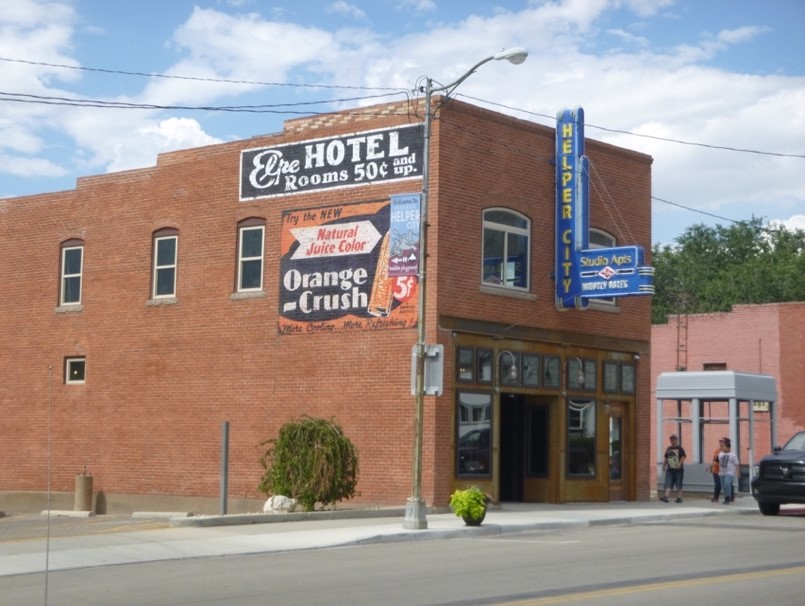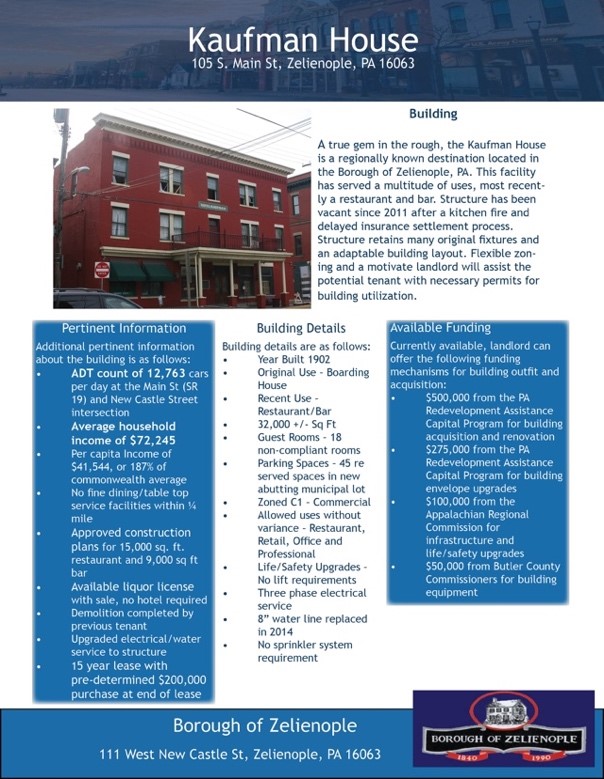June 3, 2019 | Creating Development-Ready Communities | By Ben Levenger, President of Downtown Redevelopment Services |
 Example of development-ready building: Helper, UT – September 2018
Example of development-ready building: Helper, UT – September 2018
A downtown is a collection of inanimate objects—specifically, buildings, businesses, and circulation systems—all provided to convey the public to a central location within the community. What is often forgotten is that a downtown is only as strong as the merchants, tenants, and services that support the local community, each of which is a critical piece in the overall “fabric” for the civic space that is downtown. It is this simple. Yet it is a realization that continues to elude many downtown associations or municipalities who struggle to properly leverage private development that can revitalize a downtown corridor, create sustainable jobs and provide desired amenities.
After years of working with communities across the country to identify strategies for community revitalization, it has become abundantly clear that in order for a community to attract the style and density of development that will fill these critical places within a community, it must become “development-ready.” While this statement seems very basic and obvious, the steps or processes to achieve this state are often thought of as only being the responsibility of the private development realm. This could not be further from the truth. By preparing your community for development, you are signaling to the private development companies that your community has taken the necessary steps to encourage growth within your downtown corridors and your community is welcoming their efforts presence.
Becoming development-ready
In order to send this signal to developers, a community should complete the necessary DUE DILIGENCE steps during the first 60 to 90 days of their investigation process. These steps are easily undertaken by local municipal staff, Main Street programs, board members, or even consultants.
The common elements of developer-ready due diligence are:
- Downtown “Gap” Analysis — Identification of the current “gaps” in goods or services is critical to identifying the services that will flourish within a downtown. There are numerous databases or services available to Main Street Communities or municipalities to assist with this, such as the ESRI Business Analyst Database and Main Street America’s Market Analysis for Community Transformation Guide. These tools will help you pinpoint what specific services your community is under-served in and the potential for future expansion.
- Adaptive Reuse Analysis — While it is important to understand what services would complement a strong downtown, it is equally important to understand where they can fit within the downtown. Completing a comprehensive analysis of vacant or underutilized downtown structures will provide the Main Street organization or municipality with a detailed report of which spaces are ideally situated for specific styles of development. By being better able to match ideal spaces with uses you are allowing a symbiotic relationship to form between developers, landlords, and businesses.
- Landmark Building Identification — Not all landmark buildings are historic. A community should identify buildings that spark memories or have an intrinsic value to residents. If these buildings are not used or are allowed to deteriorate they will have a detrimental impact on overall civic pride within the community. Through identification of these buildings the community will be able to ensure they are adequately preserved and utilized for the betterment of the community.
- Planning and Zoning Analysis — Communities or Main Street organizations often believe that it is the developers who are not willing to complete the normal bureaucratic process for planning and zoning amendments. While this may sometimes be the case, it is not always so. Often communities have too many levels of bureaucracy and review to create the necessary partnership with private developers. As with all things in life, both sides must be willing to compromise for the betterment of the community as a whole. Communities should analyze their internal review processes to ensure that they are streamlined, easy to understand, and there is a single point of contact for all necessary work.
- Developer Due Diligence Reports — A clear, concise and detailed document should be created based upon the detailed analysis of the findings from the previous tasks. This report will sum up all information that is typically identified and reviewed during the due diligence process of an acquisition, including but not limited to:

- Building information
- square footage
- floor plans
- year built
- current status
- Interior/exterior pictures
- Average daily traffic counts
- Current zoning and allowed uses
- Concessions the community is willing to provide to developer
- Community demographics
- average household income
- average per capita income
- documented expendable income per capita
- annual household income
- retail expenditures
- Community-desired amenities or services
- Results of the “GAP” analysis pertinent to the community-desired amenities or services.
- Building information
It is through the creation of this document that a clear and concise double-sided sheet of paper is created. This document can be kept on file for inquiries or sent directly to private development companies to spur interest. These reports can be completed for multiple buildings as they come onto the market, aiding in marketing to the right developer at the right time.
Photo: Example of a Due Diligence Report: Zelienople, PA
Benefits of becoming development-ready
The process to complete this type of work does not require a special skill set or education. It requires a group of passionate individuals who are willing to put in the effort to transform their downtown corridors. If such a group of individuals can be identified and can work together toward the goal of becoming development-ready, the community as a whole will be better able to:

- attract and retain the style and density of development required to make a sustainable community
- fill gaps in necessary goods and services for local residents
- leverage private funds to encourage further economic development
- encourage creation of a vibrant and strong downtown corridor
- directly pursue appropriate developers for community purposes
- ensure that the community’s vision is met through increased development opportunities
- deter unnecessary demolition of historic or significant properties
- bring currently vacant buildings back into tax-generating status
- increase the volume and variety of goods and services to locals in order to encourage local spending
- shorten the average private development process for an individual property by four (4) to eight (8) months.
Photo: Example of development-ready building: Evanston, WY – September 2018
Conclusion
While preparing your community for development may not be the most glamorous role that your organization undertakes, it is definitely the most important. Through these simple steps, your community will be able to ensure all downtown corridors have adequate interest to attract users year-round. Helping your community become development-ready will ensure that the downtown becomes the center of activity for your town and will remain that way for generations to come.
About the author:
Ben Levenger is an AICP planner and registered landscape architect. He is the president of Downtown Redevelopment Services, LLC, a boutique planning firm specializing in assisting communities through building adaptive re-use and developer-readiness projects throughout the continental United States. He also is a “member-at-large” in the Cleveland section of APA and serves on the membership committee for the Cleveland section of ULI.




